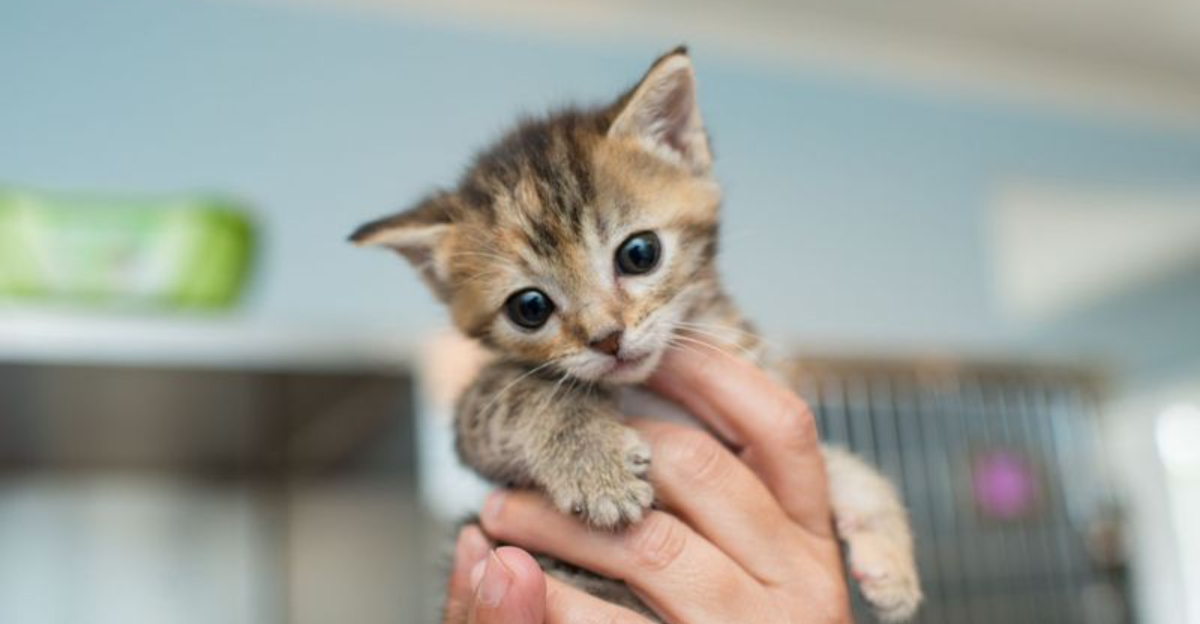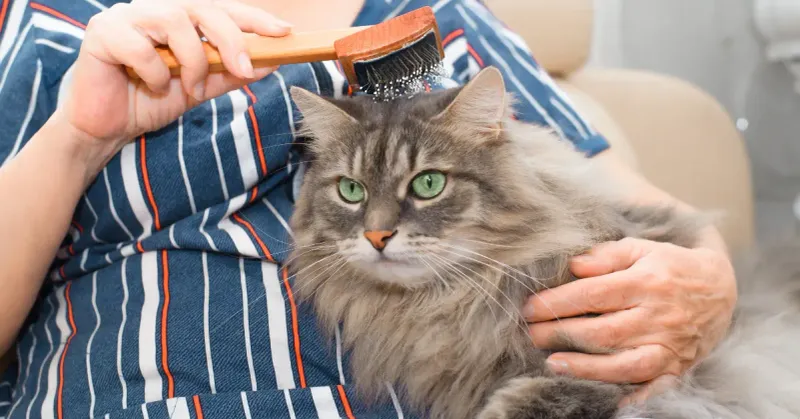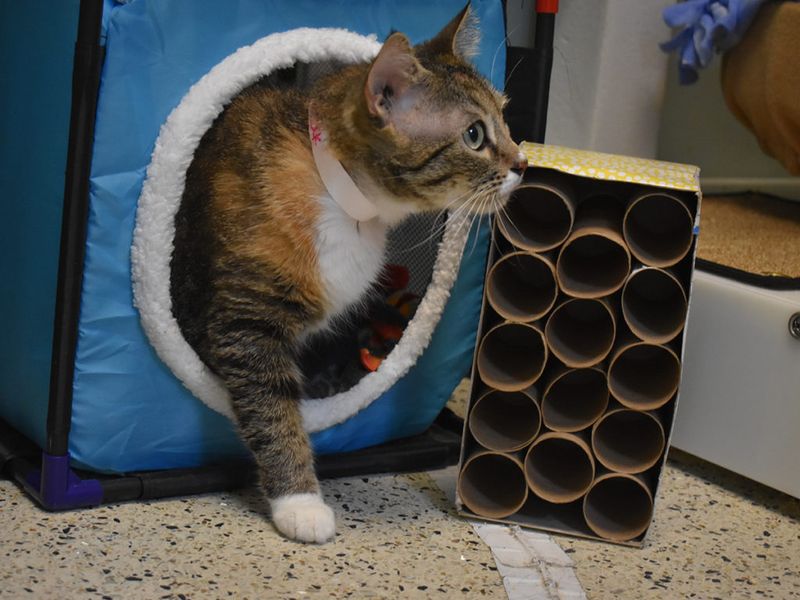📖 Table of Content:
- 1. Create a Cozy Safe Space
- 2. Practice Patience During Adjustment
- 3. Establish a Consistent Routine
- 4. Provide Proper Nutrition
- 5. Schedule a Veterinary Check-up
- 6. Encourage Play and Exercise
- 7. Master the Art of Gentle Grooming
- 8. Learn Their Communication Style
- 9. Create Vertical Territory
- 10. Use Positive Reinforcement Training
- 11. Socialize at Their Pace
- 12. Address Behavioral Challenges Compassionately
- 13. Offer Enrichment Activities
- 14. Give the Gift of Time
Shelter cats often come from difficult backgrounds, having experienced abandonment, neglect, or loss. When you adopt one of these resilient felines, you’re not just gaining a pet – you’re giving a second chance at happiness. Your love and attention can completely transform a formerly homeless cat from a nervous, untrusting animal into a confident, affectionate companion.
1. Create a Cozy Safe Space
Every shelter cat needs a dedicated sanctuary when first arriving home. Set up a quiet room with minimal traffic where your new friend can decompress and adjust at their own pace. Include a soft bed, hiding spots like boxes or cat caves, and familiar items from the shelter if possible.
This helps maintain continuity during a stressful transition. Many cats take days or even weeks to feel secure in a new environment. Patience during this period builds the foundation for trust that will define your relationship for years to come.
2. Practice Patience During Adjustment
Cats rescued from shelters carry emotional baggage that requires understanding. Some may hide under furniture for days, while others might show fear-based aggression or excessive neediness. Let your new companion set the pace for interaction.
Sitting quietly in the same room, reading a boo,k shows you’re present without being threatening. Progress happens in tiny increments – the first time they eat while you’re in the room, their first cautious approach, the first purr. Celebrating these small victories makes the journey rewarding for both of you.
3. Establish a Consistent Routine
Structure provides security for cats who’ve experienced chaotic shelter environments. Feeding, playing, and cuddling at regular times help your new companion predict what happens next, reducing anxiety. Morning and evening rituals become anchoring points in your cat’s day.
Even simple consistency like refreshing water at the same time builds a sense of stability. Shelter cats who know what to expect regain confidence faster. Their transformation from constantly vigilant to relaxed companion often hinges on the predictability you create in their daily life.
4. Provide Proper Nutrition
Many shelter cats arrive undernourished or with digestive issues from stress and inconsistent feeding. Quality food appropriate for their age and health needs forms the foundation of their physical recovery. Gradual transitions prevent tummy troubles.
Mix increasing amounts of new food with whatever they ate at the shelter over 7-10 days. Weight gain, improved coat condition, and increased energy are rewarding signs your nutritional care is making a difference. Some shelter cats who seemed lethargic or unwell blossom into playful companions once their nutritional needs are properly addressed.
5. Schedule a Veterinary Check-up
Early health assessment establishes a baseline and catches issues that shelters with limited resources might miss. Even cats with recent shelter vet care benefit from a thorough examination. Dental problems, ear mites, and chronic conditions often go undetected in busy shelter environments.
Your veterinarian can create a tailored health plan addressing your specific cat’s needs. Regular vet visits throughout your cat’s life prevent small issues from becoming serious problems. The investment in preventative care not only saves money long-term but gives your shelter cat the comprehensive healthcare they may have never experienced.
6. Encourage Play and Exercise
Active play sessions transform shelter cats physically and emotionally. Interactive toys like wand teasers mimic hunting behaviors, providing mental stimulation and building confidence. Short, frequent play periods work better than marathon sessions.
Even five minutes several times daily helps burn energy and strengthens your bond. Formerly withdrawn cats often reveal playful personalities once they feel secure enough to engage. The transition from cautious observer to enthusiastic player marks a significant milestone in your shelter cat’s journey to becoming a well-adjusted companion.
7. Master the Art of Gentle Grooming
Regular grooming sessions serve dual purposes: maintaining physical health while building trust through positive touch. Start with brief sessions using a soft brush, focusing on areas most cats enjoy like cheeks and chin. Shelter cats with matted fur or poor coat condition particularly benefit from consistent grooming.
The improvement in appearance parallels their emotional healing. The physical contact during grooming releases feel-good hormones for both of you. For cats who experienced limited handling in shelters, these sessions teach them that human touch brings comfort rather than stress.
8. Learn Their Communication Style
Each shelter cat speaks a unique dialect of feline language. Some communicate with subtle ear positions and tail twitches, while others are more vocal about their needs. Paying attention to your cat’s individual signals prevents misunderstandings.
A cat who flattens ears during petting isn’t being difficult – they’re communicating overstimulation. Responding appropriately to their cues builds trust faster than any other approach. When shelter cats realize you understand and respect their boundaries, they often become more expressive and affectionate, gradually revealing their true personalities.
9. Create Vertical Territory
Cats naturally seek elevated perches for security and observation. Cat trees, window shelves, and cleared bookcase tops transform your living space into a three-dimensional territory that meets this instinctual need.
Vertical spaces provide escape routes from stressors like visitors or other pets. For shelter cats accustomed to cage living, the freedom to climb and perch represents true liberation. The confidence gained from having a safe high ground often translates to overall behavior improvement. Many formerly skittish shelter cats become more social once they know they can retreat upward whenever they feel overwhelmed.
10. Use Positive Reinforcement Training
Clicker training and treat rewards build confidence in shelter cats while teaching useful behaviors. Simple targets like coming when called or entering carriers willingly reduce stress during necessary handling. Training sessions provide mental stimulation that many shelter environments couldn’t offer.
The cognitive engagement helps cats overcome boredom-related behaviors like excessive grooming. The process strengthens your communication and builds trust through predictable patterns. Even shy cats often blossom during training as they learn that interaction with you consistently leads to positive outcomes rather than unpredictable or negative experiences.
11. Socialize at Their Pace
Gradual introduction to new people helps formerly isolated shelter cats develop social skills. Start with calm visitors who understand the importance of letting the cat approach them. Controlled exposure builds confidence without overwhelming.
Keep initial meetings brief and pair them with positive experiences like treats or play. The transformation from hiding when the doorbell rings to greeting visitors with curiosity marks significant emotional growth. Many shelter cats who initially fear strangers become social butterflies once they learn that new humans generally bring good experiences rather than threats.
12. Address Behavioral Challenges Compassionately
Shelter cats sometimes develop coping mechanisms like inappropriate elimination or aggression. Behind every challenging behavior lies an unmet need or past trauma requiring patience to address. Environmental modifications often solve problems without confrontation.
Additional litter boxes, synthetic calming pheromones, or more structured play can transform behavior. Professional guidance from veterinarians or certified animal behaviorists provides solutions for complex issues. Many behaviors that might cause a cat to be returned to a shelter can be resolved with the right approach, giving your companion the chance at stability they deserve.
13. Offer Enrichment Activities
Food puzzles, window perches, and rotating toys prevent boredom while satisfying natural instincts. Mental stimulation is particularly important for cats who spend long periods in understimulating shelter environments. Sensory experiences like cat-safe plants or bird feeders visible from windows create engagement.
These enrichment opportunities allow cats to express natural behaviors like hunting and exploring. The difference in a shelter cat’s demeanor after implementing enrichment can be remarkable. Cats who seemed withdrawn or depressed often become more active and engaged with their surroundings, showing you glimpses of their true personalities.
14. Give the Gift of Time
Simply being present creates security for cats who have experienced abandonment. Reading aloud, working on your laptop, or watching TV in the same room builds connection without pressure. Quiet companionship allows shelter cats to observe and learn about you at their own pace.
This non-demanding presence helps them understand that your relationship doesn’t always require active interaction. The transition from keeping distance to choosing to be near you represents profound trust development. Many adopters find that the most meaningful bonding happens during these unstructured moments of simply sharing space together.














